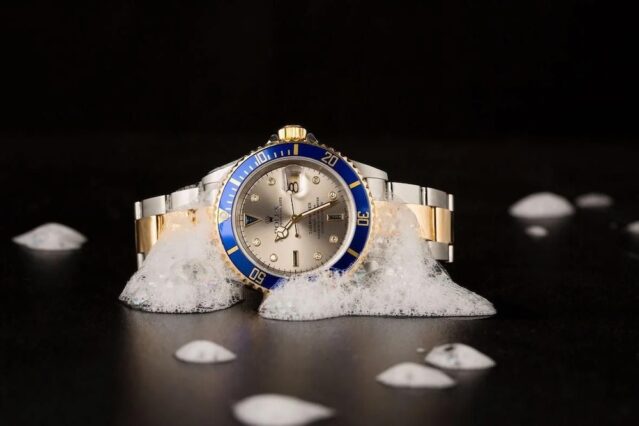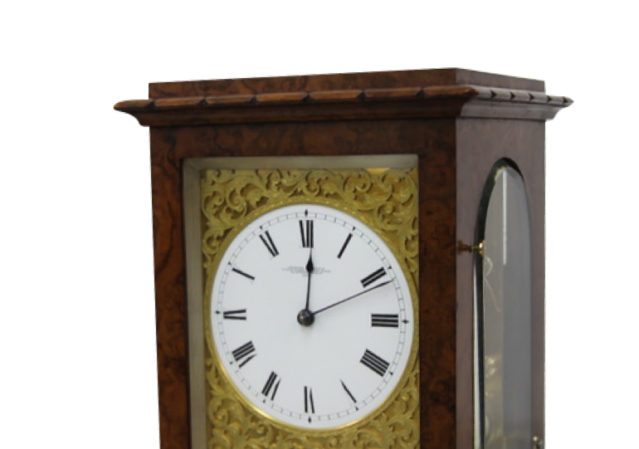How clean is your watch? Or rather – how clean do you think it is???
Just like your hands, your watch can be a breeding ground for bacteria. Not a pleasant thought but nothing a professional watch cleaning can’t remedy.
As well as detracting from the natural beauty and luster, sweat, oils, dust and dirt can also interfere with the functionality of your watch. For example, you might notice the crown or bezel sticking, chronograph pushers becoming inoperable, the bracelet stretching or the movement being a bit sluggish.
Watch cleaning requires careful attention to detail to avoid damaging delicate components. If unsure, we would always advise getting it done professionally, giving you peace of mind that your watch is in safe hands. Our bespoke valeting and watch refurbishment service aims to restore your watch to a factory finish. We have a purpose built polishing room with specialist equipment for bringing the shine back to your watch.
We are also very aware of the integrity of vintage watches and will advise you on the most appropriate method of cleaning or refurbishing.
However, if you do decide to do it yourself, below are a few expert tips from the professionals at Michlmayr.
Is my watch water resistant?
Yes – great but it’s imperative you make sure that the winding crown is fully screwed down against the case before your watch comes into contact with water. Failure to do this may result in water getting inside your watch, and depending on the extent of the moisture intrusion, expensive repairs may be necessary.
No, and this will be the case with most vintage watches, we suggest professional cleaning.
What you will need:
- Microfiber cloth – not a polishing cloth as these can contain abrasives that can actually further damage the surface finish of your watch.
- Soft bristle brush (like a toothbrush).
- Mild soap or watch cleaning solution (you can buy watch cleaning kits on Amazon)
- Toothpick or wooden pick.
- Watchmaker’s screwdriver set (if applicable).
- Compressed air (optional).
Watch cleaning work space:
- Work in a clean, well-lit area.
- Lay down a soft cloth to prevent scratching the watch’s surface.
Remove the Strap/Bracelet:
- If you feel comfortable with doing so, detach the strap or bracelet from the watch to clean it separately.
- Use a spring bar tool to remove the strap or bracelet safely.
- Once the bracelet has been removed from your watch, you can access the area between the lugs on the case and the inner surfaces of the bracelet’s end-links.
Clean the Case:
- Dip the soft bristle brush in mild soap or watch cleaning solution.
- Gently scrub the case, paying attention to crevices and hard-to-reach areas.
- Very carefully use a toothpick or wooden pick to remove dirt from small gaps, taking care not to damage anything.
- Even with the bracelet removed, there may still be certain areas of your watch that cannot fully be accessed until the watch is disassembled (such as underneath the bezel). These areas will be fully cleaned during routine servicing
- Wipe the case with a damp microfiber cloth to remove soap residue.
- Dry the case thoroughly with a clean microfiber
Clean the Crystal:
- Use a microfiber cloth to gently wipe the crystal in a circular motion.
- For stubborn dirt or fingerprints, dampen the cloth slightly with water.
- Avoid using abrasive materials or harsh chemicals that may scratch the crystal.
Clean the Strap/Bracelet:
- If the strap is leather, use a mild leather cleaner and a soft cloth to gently wipe away dirt and grime. Allow it to air dry.
- For metal bracelets, soak them in warm, soapy water and scrub gently with a soft brush. Rinse thoroughly and dry with a soft cloth.
- For fabric or nylon straps, gently scrub them with mild soap and water using a soft brush. Rinse and air.
Reassemble the Watch:
- Once all components are dry, reattach the strap or bracelet to the watch.
- Ensure that the spring bars are securely in place.
Final Inspection:
- Inspect the watch under good lighting to ensure it’s clean and free of any residue.
- Check for any loose components or damage that may need professional attention.
Scratches:
- If after completing your DIY clean, your watch still has scratches on the case or bracelet, you might consider having it professionally polished. We do not advise you try and do this yourself as you can cause irreparable damage and greatly reduce the value of the watch.
Remember, if you’re unsure at all about the watch cleaning DIY process , it’s always best to seek help from a professional watchmaker to avoid accidental damage. Contact us for a quote today.


